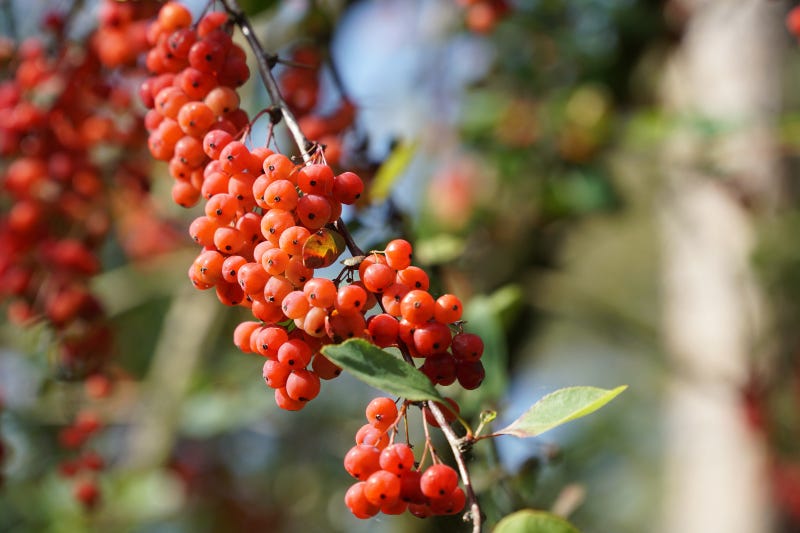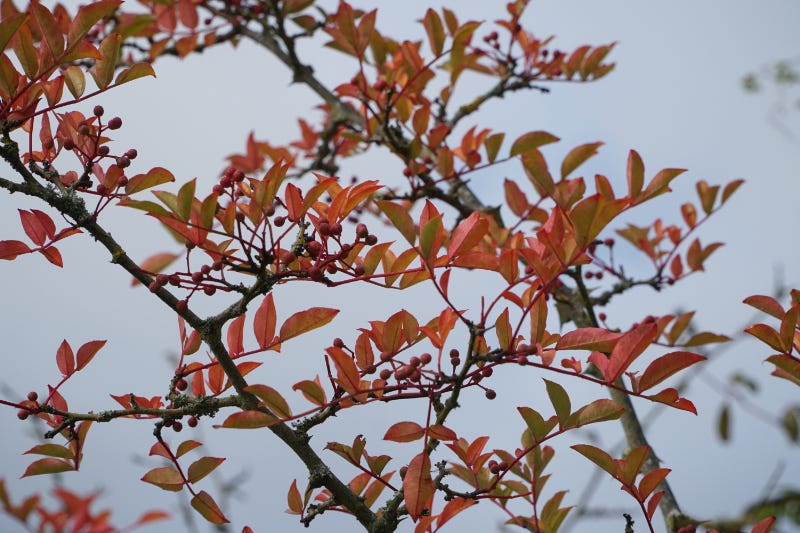Colourful gardens are in! Having seen more muted colour palettes over recent years there is now a trend towards breaking out the vibrant colours. Think reds, oranges and purples, a colour palette that reminds me of autumn. It is very much in evidence at the moment, whether wandering past trees as the leaves change colour or the last of the flowers in the garden before we start seeing frosty mornings.
Acer palmatum 'Osakazuki'
Smaller trees for gardens
While enjoying walking past the autumnal leaves on the horse chestnut and oak trees there are plenty of smaller trees for a garden setting. Rowans such as Sorbus aucuparia have a long season of interest with white flowers in the spring followed by leaves that turn from green to yellow and red before dropping off. Acers are the quintessential autumn tree ranging from pink tinged leaves through to yellows, vibrant oranges and scarlet to light up the landscape. Acer palmatum 'Osakazuki' has vibrant orange leaves that turn scarlet that will light up the garden even on the greyest day or perhaps the deep purple leaves of Trompenburg.
Sorbus aucuparia
I love Crab apples and the way they add interest to a garden from spring all the way through to the apples dropping off or disappearing (whether as a food source for birds or to make crab apple jelly). Ranging from the orange and scarlet fruits of Malus ‘John Downie’ to the bright red of Malus x robusta ‘Red Sentinel’, often used as pleached trees to line a wall or walkway. Malus ‘Harry Baker’, one that I have in my garden and love with its deep red fruits and green and purple leaves. Amerlanchier lamarckii is another tree with lots of interest, starting with delicate white flowers in spring followed by berries through to late autumn. The leaves start off bronze turning green and through to yellow then red in the autumn. For even smaller spaces it also comes as a multi-stem shrub, perfect for underplanting or lighting up.
Amerlanchier
Flowers
One particular flower that includes all these colours in its palette is the dahlia, whether preferring the simple petals of Totally Tangerine, a deep orange centre with apricot and blush petals. Or the bright red of Bishop of Auckland. To the big blousy deep red-purple blooms of Karma Choc and the bronze and apricot petals of Babylon Bronze. The pompom varieties make a fabulous cut flower, perhaps the oranges of Mystery Fox or Brown Sugar. Verrone’s Obsidian is an unusual dahlia variety with delicate deep red (almost black) reflex petals. One that would be beautifully offset planted in front of a few grasses, perhaps the native Deschampsia cespitosa or the whispy leaves of Stipa tenuissima.
Dahlia 'Chat Noir'
Many Crocosmia are providing one last hurrah at the moment, if you’re looking for smaller flowers that don’t need special treatment (dahlia tubers will need lifting soon and overwintering). Ranging from the delicate orange of Crocosmia ‘Orange Pekoe’ or the deeper oranges of Crocosmia x crocosmiiflora ‘Emily Mackenzie’ and Carmin Brillant. Through to vivid scarlets of Lucifer or Emberglow. Or the daisy like flowers of sneezewort, Helenium ‘Waltraut’ with its yellow and orange petals or the brilliant red of Ruby Tuesday. Often found in prairie planting schemes mixed in with whispy grasses, maybe Miscanthus sinensis ‘Silberspinne’.
Helenium 'Waltraut'
At the deeper purple-red end of the spectrum the spikes of Bistorta amplexicaulis 'Firetail' will add highlights through the border. For a really deep purple and ideal plant for the front of a border are the velvet flowers of Penstemon 'Pensham Plum Jerkum' or Raven. Further back the umbels of Angelica gigas add an architectural element to the border and will still add interest to a winter border, glittering on a frosty sunny morning.
Penstemon 'Raven'









